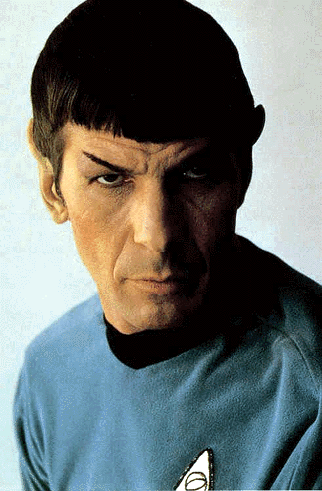 STARFLEET
HISTORICAL DATABASE FILE: Spock
STARFLEET
HISTORICAL DATABASE FILE: Spock  STARFLEET
HISTORICAL DATABASE FILE: Spock
STARFLEET
HISTORICAL DATABASE FILE: Spock
Full Biography Mode
Played By: Leonard Nimoy
Rank: Captain, retired
Serial number: S179-276SP
Full Name: Spock (lineal Vulcan name unpronounceable)
Year of birth: 2230
Place of birth: Shi'Kahr, Vulcan
Parents: Ambassador Sarek and his wife Amanda Grayson
Education: Starfleet Academy, 2249-53
Marital status: Once married
Last whereabouts: Romulus
Starfleet Career Summary
2252 -- As cadet, assigned under Capt. Christopher Pike, U.S.S. Enterprise
2253 -- Commissioned as ensign, still aboard Enterprise under Pike
2265 -- As lieutenant commander, named first officer and science officer under Capt. James T. Kirk aboard Enterprise; promoted to commander soon after
2269 -- Retired from Starfleet
2271 -- Reactivated commission during V'Ger crisis under Kirk on refit Enterprise
2277 -- Promoted to captain, assigned to Starfleet Academy faculty and cadet training with Enterprise
2285 -- Relinquish cadet-filled U.S.S. Enterprise to Kirk for rescue of Project Genesis team
2286 -- Though uncharged, stands with Kirk and shipmates for theft of Enterprise charges
2287 -- Accompanies Kirk aboard NCC-1701-A Enterprise for Nimbus III mission
2293 -- Envoy to UFP-Klingon peace accords, spurred by explosion of Klingon moon Praxis
Spock's mother, Amanda Grayson, was a human schoolteacher from Earth and his father, Sarek, was a respected diplomat. For most of his life, Spock was torn between his emotional human side and the stern discipline of his Vulcan half until his experience with the V'Ger machine-entity in 2271 and his later death and rebirth in 2286 broadened his perspective. As of 2267 he had earned the Vulcanian Scientific Legion of Honor, had been twice decorated by Starfleet Command and held an A7 computer expert classification.
As a child, Spock had a pet sehlat, which is a cuddly Vulcan bear-like animal with claws and fangs. His older half-brother, Sybok, who was ostracized from Vulcan because he rejected the way of pure logic, was killed in 2292 after battling an alien entity at the galaxy's center that claimed to be 'God.'
At age seven, Spock was telepathically bonded with a young Vulcan girl named T'Pring. The telepathic touch would draw the two together when the time was right after both came of age: once every 7 years all Vulcan males experiences pon farr, a powerful Vulcan mating drive which demands that they mate or die. In 2267, however, T'Pring chose Stonn, a Vulcan, over Spock, and the Vulcan returned to the U.S.S. Enterprise unwed. He did eventually marry in a ceremony attended by Lt. Jean-Luc Picard.
Because the young Vulcan chose to join Starfleet, he and Sarek opened an 18-year rift over Sarek's hope his son would attend the Vulcan Science Academy. Spock was the first Vulcan to enlist in the Federation Starfleet, serving aboard the U.S.S. Enterprise under Captain Christopher Pike as a lieutenant, and later for James T. Kirk.
After the conclusion of the U.S.S. Enterprise's first five-year mission, Spock retired from Starfleet and returned to Vulcan to pursue the emotion-purging of the kohlinar discipline from the Vulcan Masters. Although he completed the training, Spock failed to achieve kohlinar because his emotions were stirred by the V'Ger entity in 2271. He then reentered Starfleet and was eventually promoted to U.S.S. Enterprise captain when that ship was assigned as a training vessel at Starfleet Academy.
Spock sacrificed himself in 2285 to repair plasma conduits that allowed the U.S.S. Enterprise and its crew to escape from the detonation of the Genesis Device by Khan Noonien Singh; his radiation-wracked body was consigned to space but landed on the newly formed Genesis Planet and began regeneration. Prior to his death, Spock had mind-melded with McCoy to transfer his katra, apparently intending for his longtime friend and sparring partner to return it to Vulcan and perhaps be fully regenerated in the fal-tor-pan or refusion process, conducted for the first time in generations.
In later years, Spock's work became more diplomatic than scientific, initially remaining a part of Starfleet. In 2293, he served as Federation special envoy to the Klingon government, paving the way for the Khitomer peace accords with Chancellor Azetbur, and disappointed in that his protTgT, Lt. Valeris.
In the coming decades as a civilian, in 2368, Spock secretly traveled to Romulus on a personal mission to further the cause of Romulan/Vulcan reunification - a mission which shook up the Federation so that Captain Jean-Luc Picard was sent undercover to determine his motives. On the same trip he was saddened to hear of the death of his father, Sarek, but Picard's presence allowed Spock a final last solace thanks to an earlier Picard-Sarek mind meld. Spock remained to work with the Romulan underground and in 2369, helped arrange the defection of Romulan vice-proconsul M'Ret to the Federation to pioneer an escape route for dissidents.
Spock carried a life-long interest in art, music, literature and poetry from many worlds, especially Terran, and played both tri-dimensional chess as well as the Vulcan lute or harp and a keyboard harpsichord.

The son of Jewish immigrants from the U.S.S.R., Leonard Nimoy was born in Boston in 1931. His first stage appearance was in "Hansel and Gretel" at age eight. After a short stint at Boston College, he came to California in search of an acting career.
In 1954 he married Sandi Zober, an actress. Then Nimoy went into the Army and spent 18 months serving in Georgia, at Ft. McPhearson. He wrote, narrated and emceed GI shows for the Army's Special Services branch. During that time he directed and played "Stanley" in the Atlanta Theater Guild's production of "A Streetcar Named Desire."
After his discharge from the Army, Nimoy enrolled in the Pasadena Playhouse in California. He worked as a soda jerk, movie usher and cab driver to pay the bills while he studied acting. Eventually he left the playhouse, his sights on a film career, rather than theater.
Nimoy ran a drama studio in North Hollywood for three years and taught for a year at Synanon; by now he had two children, Adam and Julie.
Nimoy's film debut was in the movie, "Queen for a Day," in 1951. It was a theatrical film based on the popular television series of the early fifties. Next he did "Rubarb," where he played one of the baseball players whose team is inherited by a cat.
His first starring role was in 1952 as "Did Monk Baroni," a youth with a deformed face who becomes a winning boxer. It was then back to lesser roles for the films "Francis Goes to West Point," and "Zombies of the Stratosphere." He also had a small role in "Old Overland Trail," a B-Western by Republic Pictures.
In the 60's, Nimoy began to break into television. He made guest appearances on many series, including, Rawhide, The Virginian, Profiles in Courage, Dr. Kildare, and Outer Limits. Nimoy had a recurring role on the popular series, Sea Hunt, starring Lloyd Bridges.
Nimoy's first meeting with Gene Roddenberry came when he guest starred in an episode of The Lieutenant.
Finally came his big break in 1966 when he began his role as Spock on Star Trek. His first promotional trip for that show was when he was Grand Marshall of Medford, Oregon's annual Pear Blossom Festival. It was the first sign that he'd finally made it. This idea was confirmed after the Pear Blossom Parade when Nimoy signed autographs for a crowd of fans so large officials had to "rescue" him from the well-meaning autograph seekers. Then, when TV Guide featured his picture and article in their March 4, 1967 issue, he was sure of it.
Given this new popularity, Nimoy won roles in several stage roles, "Monserrat, "Visit to a Small Planet," and "Cat on a Hot Tin Roof."
Trying another talent, in 1967 Nimoy released his first record album, based on the Star Trek character of Mr. Spock. Leonard Nimoy Presents Mr. Spock's Music from Outer Space, the album produced a hit single, "Visit to a Sad Planet." The sales of these records were so good, he made a second album, The Two Sides of Leonard Nimoy, with Spock's character on one side and Nimoy as himself on the other. The album contained songs and poetry set to music. Nimoy went on to release three more albums, these primarily folk music and his own renditions of popular songs. Nimoy also made five narrative albums in the 1970s, including readings from "War of the Worlds" and "The Martian Chronicles."
When Star Trek ended in 1969, Nimoy joined the Mission: Impossible team as a regular, replacing Martin Landau. He stayed with the show for two years.
In 1971, Nimoy starred in "Fiddler on the Roof," and then third billing in "Catlow," the same year. In 1974, he did a TV movie called, "The Alpha Caper" and "The Missing are Deadly," in 1975. In 1975, Nimoy returned to college and earned a master's degree in education at Antioch College.
In 1977 Nimoy played Martin Dysart in the play "Equus," on the New York stage. In 1978, he starred in a remake of "Invasion of the Body Snatchers," where he played a psychiatrist who had an unusual way of making his patients face their deepest fears. Then he went on from 1978-1981 to tour the country in his one-man play, "Vincent." The play was written and directed by Nimoy, based on the play "Van Gogh" by Phillip Stephens. After more than 150 performances, "Vincent" was finally videotaped and broadcast on the A&E cable network.
In 1978, work began on the first Star Trek feature film. With some reluctance, Nimoy returned as Spock. The film was released on December 7, 1979. Nimoy went on to co-star in the next five Star
Trek films, as well as a two-part episode of Star Trek: The Next Generation, entitled, "Unification."
Nimoy's first experiences with directing a feature film came with "Star Trek III: The Search for Spock" and "Star Trek IV: The Voyage Home." That was only the beginning. Since then, he has gone on to direct "Three Men and a Baby," in 1987, "The Good Mother," in 1988, and "Funny About Love."
The television mini-series "A Woman Called Golda," and "Marco Polo" were good parts for Nimoy and helped show that he could do more than be Mr. Spock.
In 1986, Nimoy separated from his wife of 32 years and eventually obtained a divorce. Nimoy has since remarried.
One of his hobbies is black and white photography. Utilizing this talent, Nimoy published several volumes of poetry, illustrated with his photos. The first of these books was called, "Why Not You and I?"
In 1991, Nimoy starred in and produced the film, "Never Forget," for the Turner Network, which deals with a true case of a Holocaust survivor suing a neo-Nazi organization who claimed the extermination of Jews in World War II was a myth.
Filmography
1951 "Queen for a Day"
1951 "Rhubarb"
1952 "Kid Monk Baroni"
1952 "Francis Goes to West Point"
1953 "Old Overland Trail"
1954 "Them!"
1958 "Satan's Satellites"
1963 "The Balcony"
1966 "Deathwatch"
1967 "Valley of Mystery"
1971 "Catlow"
1978 "Invasion of the Body Snatchers "(remake)
1979 "Star Trek The Motion Picture"
1982 "Star Trek II: The Wrath of Khan"
1984 "Star Trek III: The Search for Spock" (also directed)
1986 "The Transformers"
1986 "Star Trek IV: The Voyage Home" (also directed)
1987 "Three Men and a Baby" (director)
1988 "The Good Mother"
1989 "Star Trek V: The Final Frontier"
1990 "Funny About Love" (director)
1991 "Star Trek VI: The Undiscovered Country " (also executive producer)
1994 "Holy Matrimony" (director)

